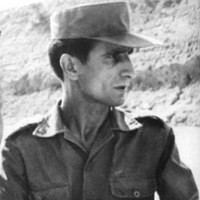Rio de Janeiro, 1937 – Buriti Cristalino (Brasil), 1971
By Daniela Jinkings
A captain in the Brazilian Army who became famous in January 1969 for deserting the 4th Infantry Regiment with 63 automatic rifles, machine guns, and ammunition, Carlos Lamarca was one of the commanders of the urban guerrilla group Vanguarda Popular Revolucionária (VPR). His feats inspired legends, films, and books. The son of a shoemaker, he studied at the Military College and the Military Academy of Agulhas Negras, where he stood out for his discipline and excellent marksmanship. Just before abandoning the Army, he had been assigned to train bank tellers to face armed actions from the left, an activity reported by the main magazines in the country, which drew even more attention to his joining the guerrilla movement. He became one of the left-wing leaders most intensely hunted by the repression, with photographs on wanted posters.
In 1966, still a lieutenant, while serving as duty officer, he allowed the escape of nationalist Colonel Jefferson Cardim from prison. This suspicion led to his first military-police inquiry. Along with the VPR, he believed the revolution should have a socialist character from the beginning, rejecting the national liberation policy advocated by Carlos Marighella. He was one of the promoters of the merger between the VPR and Colina (National Liberation Command), which resulted in the Vanguarda Armada Revolucionária-Palmares (VAR-Palmares). The movements he participated in specialized in invading barracks and spectacular actions, such as taking the safe from former Governor Adhemar de Barros, where there was 2.4 million dollars, and kidnapping foreign diplomats for the release of political prisoners.
In September 1969, Lamarca led a dissent within the VAR-Palmares, adopting the old name VPR. In the new organization, one of the prominent figures was Ladislau Dowbor, who, under the codename Jamil, sought to combine the economic theories of Andre Gunder Frank with the anti-imperialist theses of Frantz Fanon, creating the policy of armed propaganda. In the middle of 1970, the guerrilla training camp Lamarca directed in the Vale do Ribeira region, near the southern coast of São Paulo, was discovered by the repression, and he led a spectacular escape that was particularly humiliating for the Army, inflicting heavy casualties on the enemy and carrying out a bewildering maneuver to elude them.
He was married to Marina Lamarca, who went into exile in Cuba with their two children before her husband abandoned the Army. In the guerrilla movement, he met Iara Iavelberg, with whom he had an intense romance. Disagreeing with the new VPR, both joined the Movimento Revolucionário 8 de Outubro (MR-8) and, in mid-1971, moved to the state of Bahia. Iara was located by the repression in Salvador and killed in an ambush. Lamarca and a companion, the metalworker José Campos Barreto, one of the leaders of the 1968 Osasco strike, were identified in Buriti Cristalino and suffered an epic chase in the backlands of Bahia, being finally located, exhausted, under a tree in the municipality of Pintada on September 17. They were machine-gunned while they slept. After the political amnesty was signed in 1979, Lamarca was promoted to brigadier general, the same rank to which another legendary former captain, the former Secretary-General of the Brazilian Communist Party (PCB), Luiz Carlos Prestes, was also promoted.



